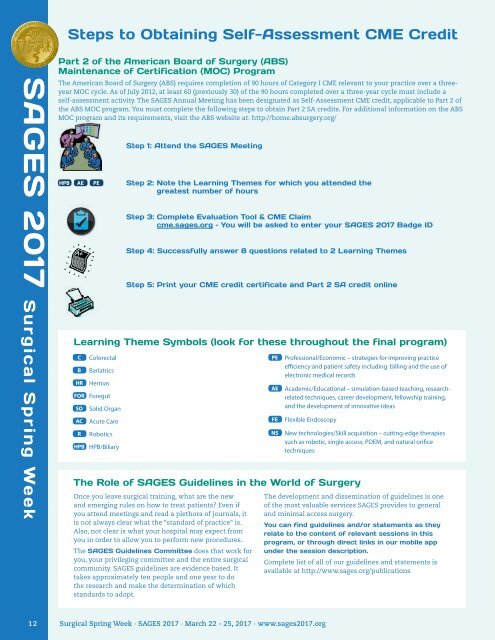SAGES 2017
Mjbg309U274
Mjbg309U274
Create successful ePaper yourself
Turn your PDF publications into a flip-book with our unique Google optimized e-Paper software.
Steps to Obtaining Self-Assessment CME Credit<br />
<strong>SAGES</strong> <strong>2017</strong> Surgical Spring Week<br />
Part 2 of the American Board of Surgery (ABS)<br />
Maintenance of Certification (MOC) Program<br />
The American Board of Surgery (ABS) requires completion of 90 hours of Category I CME relevant to your practice over a threeyear<br />
MOC cycle. As of July 2012, at least 60 (previously 30) of the 90 hours completed over a three-year cycle must include a<br />
self-assessment activity. The <strong>SAGES</strong> Annual Meeting has been designated as Self-Assessment CME credit, applicable to Part 2 of<br />
the ABS MOC program. You must complete the following steps to obtain Part 2 SA credits. For additional information on the ABS<br />
MOC program and its requirements, visit the ABS website at: http://home.absurgery.org/<br />
HPB<br />
AE<br />
PE<br />
Step 1: Attend the <strong>SAGES</strong> Meeting<br />
Step 2: Note the Learning Themes for which you attended the<br />
greatest number of hours<br />
Step 3: Complete Evaluation Tool & CME Claim<br />
cme.sages.org – You will be asked to enter your <strong>SAGES</strong> <strong>2017</strong> Badge ID<br />
Step 4: Successfully answer 8 questions related to 2 Learning Themes<br />
Step 5: Print your CME credit certificate and Part 2 SA credit online<br />
Learning Theme Symbols (look for these throughout the final program)<br />
C Colorectal<br />
B Bariatrics<br />
HR Hernias<br />
FOR Foregut<br />
SO Solid Organ<br />
AC Acute Care<br />
R Robotics<br />
HPB HPB/Biliary<br />
PE Professional/Economic – strategies for improving practice<br />
efficiency and patient safety including billing and the use of<br />
electronic medical records<br />
AE Academic/Educational – simulation-based teaching, researchrelated<br />
techniques, career development, fellowship training,<br />
and the development of innovative ideas<br />
FE Flexible Endoscopy<br />
NS New technologies/Skill acquisition – cutting-edge therapies<br />
such as robotic, single access, POEM, and natural orifice<br />
techniques<br />
The Role of <strong>SAGES</strong> Guidelines in the World of Surgery<br />
Once you leave surgical training, what are the new<br />
and emerging rules on how to treat patients? Even if<br />
you attend meetings and read a plethora of journals, it<br />
is not always clear what the “standard of practice“ is.<br />
Also, not clear is what your hospital may expect from<br />
you in order to allow you to perform new procedures.<br />
The <strong>SAGES</strong> Guidelines Committee does that work for<br />
you, your privileging committee and the entire surgical<br />
community. <strong>SAGES</strong> guidelines are evidence based. It<br />
takes approximately ten people and one year to do<br />
the research and make the determination of which<br />
standards to adopt.<br />
The development and dissemination of guidelines is one<br />
of the most valuable services <strong>SAGES</strong> provides to general<br />
and minimal access surgery.<br />
You can find guidelines and/or statements as they<br />
relate to the content of relevant sessions in this<br />
program, or through direct links in our mobile app<br />
under the session description.<br />
Complete list of all of our guidelines and statements is<br />
available at http://www.sages.org/publications<br />
12 Surgical Spring Week · <strong>SAGES</strong> <strong>2017</strong> · March 22 - 25, <strong>2017</strong> · www.sages<strong>2017</strong>.org


